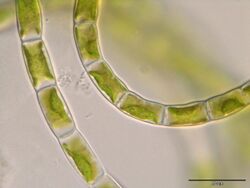Biology:Klebsormidium
| Klebsormidium | |
|---|---|

| |
| Scientific classification | |
| (unranked): | Viridiplantae |
| (unranked): | Charophyta |
| Class: | Klebsormidiophyceae |
| Order: | Klebsormidiales |
| Family: | Klebsormidiaceae |
| Genus: | Klebsormidium P.C.Silva, Mattox & W.H.Blackwell[1][2] |
| Species | |
|
See species list. | |
Klebsormidium is a genus of filamentous charophyte green algae comprising 20 species.[1] The name was proposed in 1972 to resolve confusion in application and status of Hormidium[Note 1] and was given for the German botanist Georg Albrecht Klebs.[Note 2]
The algae occurs mostly in soil and on moist substrates, nevertheless, aquatic and one marine species are also known. Many Klebsormidium-species are able to synthesize substances for UV protection, the so-called mycosporine-like amino acids. The draft genome sequence of Klebsormidium nitens NIES-2285 (called K. flaccidum at the time of publication) was published in 2014.[3]
Description
Klebsormidium forms uniseriate (one cell thick), unbranched filaments. Cells are cylindrical or barrel-shaped. The cell wall may be thin or thickened, and is sometimes made of H-shaped pieces. Each cell contains a single parietal chloroplast which encircles around 40 to 70% of the cell wall, usually with a single pyrenoid.[4]
Klebsormidium reproduces asexually but not sexually. It produces zoospores with two flagella, which are released from cells through a pore. It can also produce aplanospores and akinetes.[4]
The genus can be difficult to distinguish from Ulothrix, but Ulothrix tends to have chloroplasts that are wider and encircling nearly all of the cell.[4]
Species
The valid species currently considered to belong to this genus are:
- Klebsormidium acidophilum
- Klebsormidium bilatum
- Klebsormidium crenulatum
- Klebsormidium dissectum
- Klebsormidium drouetii
- Klebsormidium elegans
- Klebsormidium flaccidum
- Klebsormidium fluitans
- Klebsormidium fragile
- Klebsormidium klebsii
- Klebsormidium lamellosum
- Klebsormidium montanum
- Klebsormidium mucosum
- Klebsormidium nitens
- Klebsormidium pseudostichococcus
- Klebsormidium scopulinum
- Klebsormidium sterile
- Klebsormidium subtile
- Klebsormidium subtilissimum
- Klebsormidium tribonematoideum
The species of Klebsormidium are in critical need of a taxonomic revision. Traditional morphological characteristics used to delimit the taxa, such as the width of filaments or shape of cells, are unreliable and do not map well to phylogenetic groups.[5]
Notes
- ↑ Hormidium nitens G.A.Klebs 1896
- ↑ Georg Albrecht Klebs (1857-1918) Dinophyceae, Chrysophyceae and Xanthophyceae specialist
References
- ↑ 1.0 1.1 Guiry, M.D.; Guiry, G.M. (2008). "Klebsormidium". AlgaeBase. World-wide electronic publication, National University of Ireland, Galway. http://www.algaebase.org/search/genus/detail/?genus_id=42757. Retrieved 2011-01-17.
- ↑ Silva, P.C.; Mattox, K.R.; Blackwell, W.H., Jr (1972). "The generic name Hormidium as applied to green algae". Taxon 21 (5/6): 639–645. doi:10.2307/1219167.
- ↑ Hori, Koichi et al. (2014). "Klebsormidium flaccidum genome reveals primary factors for plant terrestrial adaptation". Nature Communications 5: 3978. doi:10.1038/ncomms4978. PMID 24865297. Bibcode: 2014NatCo...5.3978H.
- ↑ 4.0 4.1 4.2 John, David M.; Rindi, Fabio (2014). "Chapter 8. Filamentous (Nonconjugating) and Plantlike Green Algae". Freshwater Algae of North America: Ecology and Classification (2 ed.). Elsevier Inc.. ISBN 978-0-12-385876-4.
- ↑ Rindi, Fabio; Guiry, Michael D.; López-Bautista, Juan M. (2008). "Distribution, Morphology, and Phylogeny Of Klebsormidium (Klebsormidiales, Charophyceae) in Urban Environments in Europe". Journal of Phycology 44 (6): 1529–1540. doi:10.1111/j.1529-8817.2008.00593.x. PMID 27039867.
External links
- Images of Klebsormidium at Algaebase
Wikidata ☰ Q1460131 entry
 |


